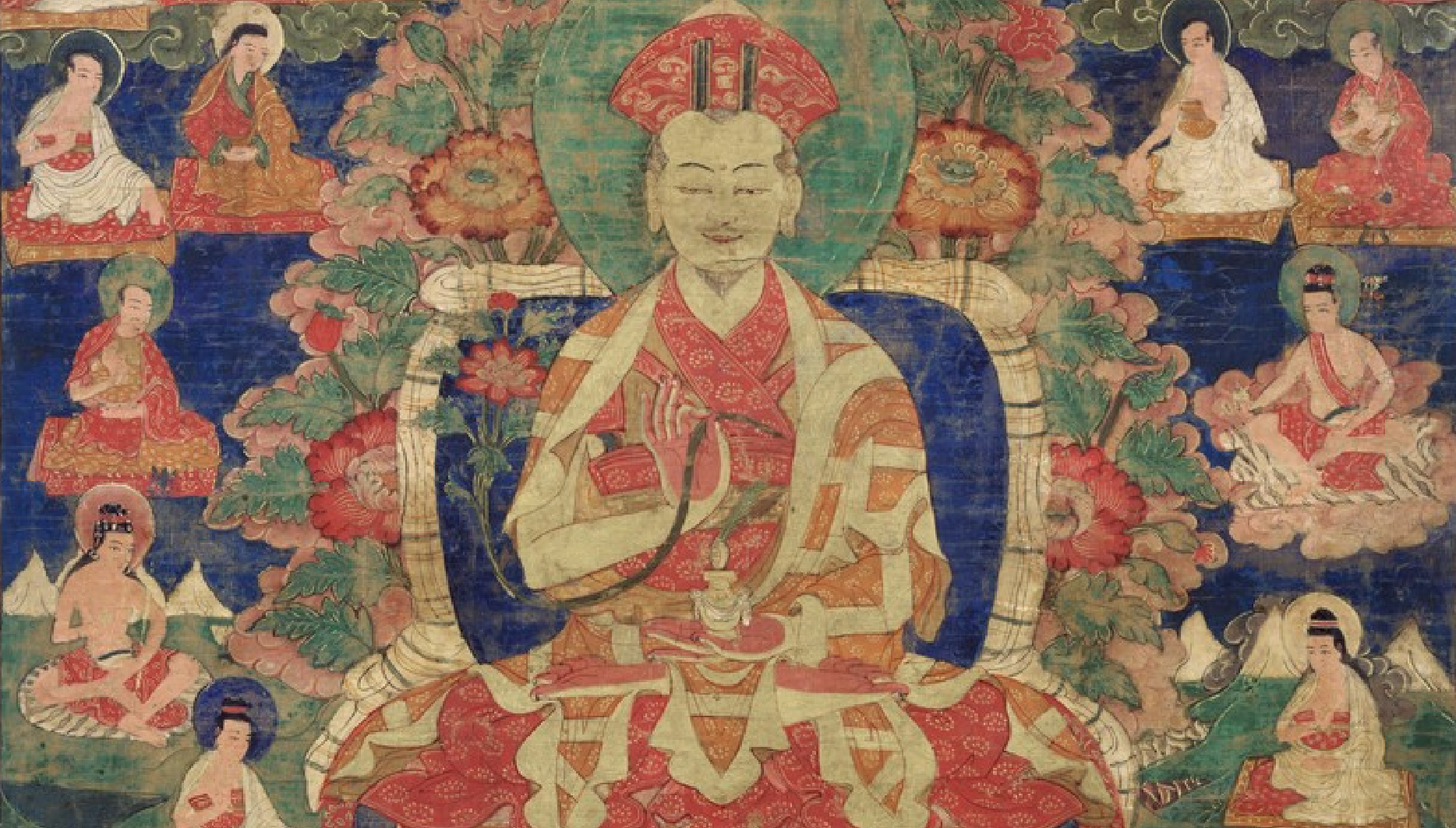
Image of an unidentified Drukpa Kagyu master from the Rubin Museum of Art collection at the Himalayan Art Resources. Bod Khepa (1618-1685) belonged to the Drukpa Kagyu school.
Our founder Gene Smith had close friendships with many of the greatest lamas of the 20th century with whom he found common ground in their shared love of texts. It was Dezhung Rinpoche, his first teacher, who expressly tasked Gene with seeking Tibetan manuscripts and blockprints, which ended up being the mission of his life. Since that time, one of BDRC's key constituents that we serve are the lamas, who look to BDRC not only for familiar scriptures for their monastic curriculum but also rare and special manuscripts that can't be found elsewhere.
When His Holiness the 17th Karmapa, Ogyen Trinley Dorje, visited BDRC in August 2018, he asked us for the Collected Works of Bod Khepa Mipham Gelek Namgyal, a great 17th century scholar who was also a great master of poetry. Many works by Bod Khepa had been published and in fact were already available from our archive, but we knew that there were a great many more texts that were still unavailable and his Collected Works was still missing. Indeed many of the works in Bod Khepa's oeuvre were unknown.
We went looking for his Collected Works and were lucky enough to find this extremely rare manuscript copy—in a very legible hand and 2500 pages long. We were delighted to share them with Karmapa, and pleased to share with the public on our open-access archive. The collection, which only came online in March of this year, comprises three volumes along with an extensive outline carefully created by our librarians detailing the title of each text in a clear table of contents. It showcases the kind of work that BDRC does, seeking and making available these rare collections from masters whose works would be lost or inaccessible otherwise.
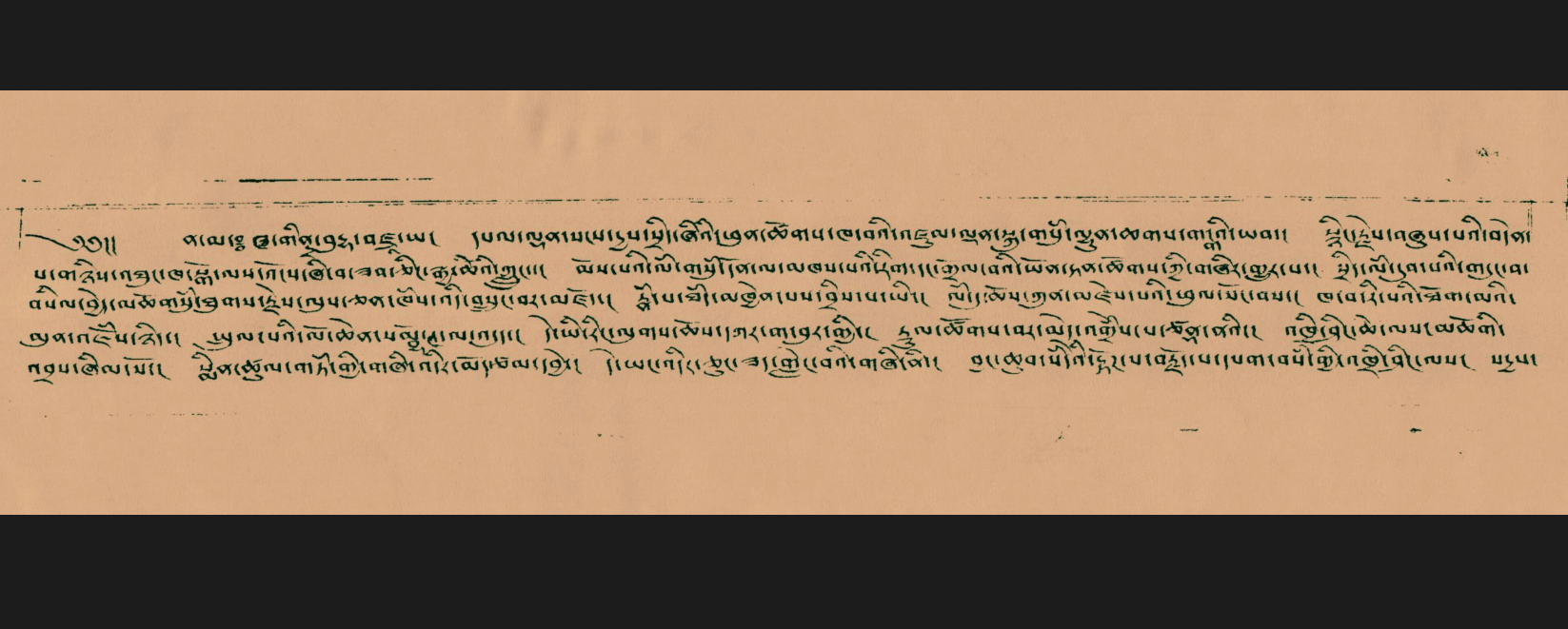
The Collected Works of the famous 17th century scholar Bod Khepa Mipham Gelek Namgyal, published to the BDRC archive in 2022.
Bod Khepa Mipham Gelek Namgyal, born in 1618 and known primarily as Bod Khepa (Bod mkhas pa), was a master in the Drukpa Kagyu tradition. His teacher was the very famous Drukpa Kagyu master Sangye Dorje, himself a student of Drukpa Pema Karpo. Bod Khepa became a great scholar of medicine and one of the greatest of Tibetan poetry masters. In 1678, at the age of 61, he wrote Ornament of Dandin's Thought, a famous commentary on the Mirror of Poetry, Kāvyādarśa. In fact, Gene Smith thought very highly of this commentary. He wrote in one of the essays in Among Tibetan Texts, "The number of Tibetan commentaries on the Kāvyādarśa, and the dper brjod stemming from this work, surpasses the imagination. Perhaps the most original among them were those of 'Jam dbyangs Khe che, Bod mkhas pa [Bod Khepa], Khams sprul Bstan 'dzin chos kyi nyi ma, and Mi pham."
Bod Khepa is still a legendary figure in Tibetan Buddhist literature, and his main writings are still studied in schools and monasteries all over. As the scholar of Tibetan literature Dr. Lama Jabb told us, "Bod Khepa is a must when one studies Kāvyādarśa in Tibetan. I had the fortune to encounter him through my Tibetan teacher Chapdak Lhamokyab when I studied Tibetan kavya poetry with him." He continued,
Bod Khepa is a brilliant and highly influential Pandita poet who is famed for his kayvic technical excellence, distillation of imagery, semantic concentration, and prosodic beauty." —Dr. Lama Jabb, Oxford University
But Bod Khepa's Collected Works has never been available outside of Tibet before. In fact, they have never been available outside of a few select monasteries. Because of the difficulty of reproducing manuscripts and the fact that only Bod Khepa's most popular works were ever blockprinted, as far as we know, this is the rare surviving manuscript of his Collected Works. It is because of BDRC's long track record of dedicated service to Tibetan Buddhist literature that we are trusted with these precious text collections by monasteries, libraries, and individuals.
Bod Khepa, the Person and the Poet
We are delighted to offer all students of Dharma, and poetry, a chance to browse through the extensive works of this great Tibetan master! After all, his accomplishments were such that he became known all over Tibet as Bod Khepa, meaning the "Wise Scholar of Tibet."
In fact, there are two stories about Mipham Gelek Namgyal's penname. When he first started using "Bod Khepa" to sign his work, he was derided by certain of his contemporaries who thought it arrogant of him. In fact, there was so much outrage and opposition to his penname that apparently Bod Khepa claimed it was a typo, meant to be "Bong mkhas pa" for "the Wise Donkey." However, according to another telling, it was not Bod Khepa himself but some contemporaries who began to write his name as "Bong mkhas pa" to mock him. But slowly, as time went on, Bod Khepa established his reputation and mastery of poetry to such an extent that he entirely earned his name Bod Khepa which has now become his epithet.
Bod Khepa was a very accomplished doctor in the Zur tradition, and wrote medical textbooks that are still studied today. His Lus thig zla wa nor bu'i me long was actually carved into woodblocks at Mentseekhang in Lhasa; it was deemed indispensable to the training of generations of doctors at this premier medical institute. He also wrote Mirror of Baidurya on the Power of Plants (sman gyi ro nus zhu rjes bshad pa bai DU rya'i me long), on the healing properties and characters of medicinal herbs. But of course, he was most known for his work on poetry.
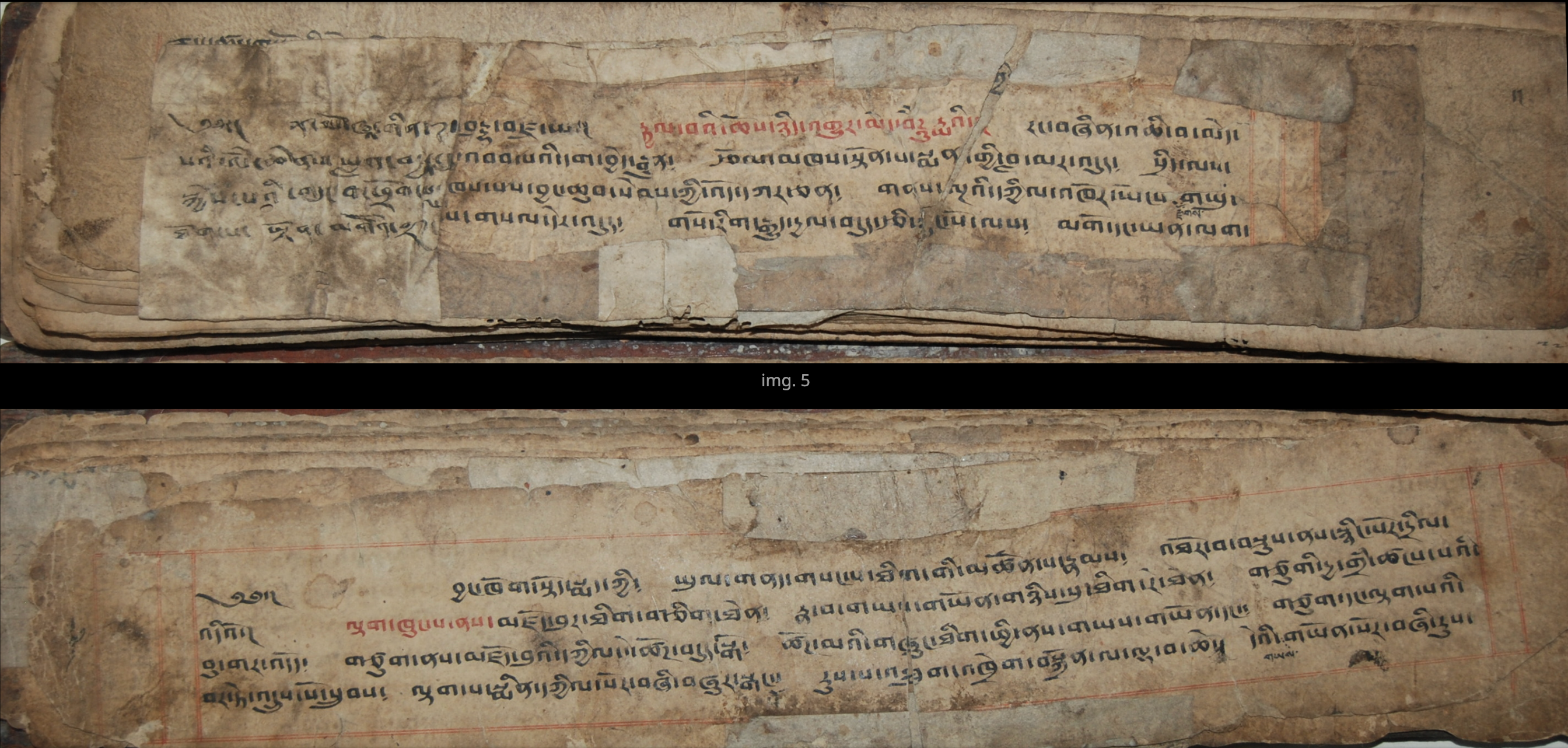
Another manuscript copy of one of his writings, Lus thig zla wa nor bu'i me long, written in the same style, only this text has needed intensive restoration over the centuries.
Among Bod Khepa's writings were multiple commentaries on the Mirror of Poetry, including of course the famous Ornament of Dandin's Thought. It was Bod Khepa who wrote the first truly extensive example of the figures of speech, the alamkara, laid out in Mirror of Poetry, the foundation poetry text for Tibetans. By doing so, he taught Tibetans how to write poetry and laid the foundations for the flourishing of Tibetan poetry in the 17th century.
This work, popularly called Dayang Gyatso, is probably the most read work of his. Its full title is snyan ngag me long gis bstan pa'i dper brjod legs par bshad pa sgra dbyangs rgya mtsho'i 'jug ngogs. The following is a selection of stanzas, from Dayang Gyatso, to give you a sense of his examples of Mirror of Poetry's alamkara.
ནེའུ་གསིང་གཡུ་ཡི་མཎྜལ་ཕྱིས་ལྟར་སྔོ།།
མེ་ཏོག་ཕྲེང་མཛེས་སྐར་ཚོགས་བཞིན་དུ་བཀྲ།།
བུང་བའི་མགྲིན་སྒྲ་རྒྱུད་མང་ལྟར་སྙན་པའི།།
དཔྱིད་ཀྱི་དུས་འདི་ལྷ་ཡུལ་ལྟ་བུར་མཛེས།།
The grassland like a clear turquoise mandala
The rosary of flowers shimmer like stars in the sky
The buzzing of bees sweet as a lute
How like heaven is the season of spring!
འཐུངས་ཙམ་ཉིད་ནས་ཅ་ཅོ་འཕེལ་བྱེད་ཅིང་།།
སྟོབས་དང་གྲགས་དང་གཟི་གདངས་ཉམས་པར་གྱུར།།
བག་མེད་རྩོད་དང་འཁྲུག་ལོང་མཐའ་དག་གི།།
གཞི་དང་རྩ་བར་གྱུར་པ་ཆང་ཉིད་དོ།།
Just a sip will start your nonsense
Degrade your power, your fame and your beauty
Invite shameless quarrels and fights
It all starts with the drink!
གྲོགས་ཀྱིས་འགོག་པ།
གྲོགས་ཁྱེད་ལོངས་སྤྱོད་བཞེད་ན་འདྲེན་བྱེད་ཀྱི།།
གཟིགས་ཚད་བྱི་བ་བཞིན་དུ་ལྐོག་གསོག་འཚལ།།
ཕྱིས་ནི་འཆི་བདག་གཏུམ་པོའི་ཤབ་རྒྱུགས་ཀྱིས།།
ཁབ་ཙམ་ཁྱེར་དབང་མེད་པའི་དུས་ཤིག་མཆི།།
Dear friend, if you want wealth
Save up like a miserly mouse
Later when the Lord of Death comes for you
You can't even take a needle with you
Bod Khepa was teaching his audience how to find beauty in nature, how to be a good Buddhist, how to live a decent life, and of course how to write poetry. We are delighted to make his entire oeuvre available so that readers interested in early modern Tibetan poetry can get a true sense of this remarkable Buddhist poet—and researchers can finally get a full picture of Bod Khepa as one of the great intellectuals of the Tibetan tradition!
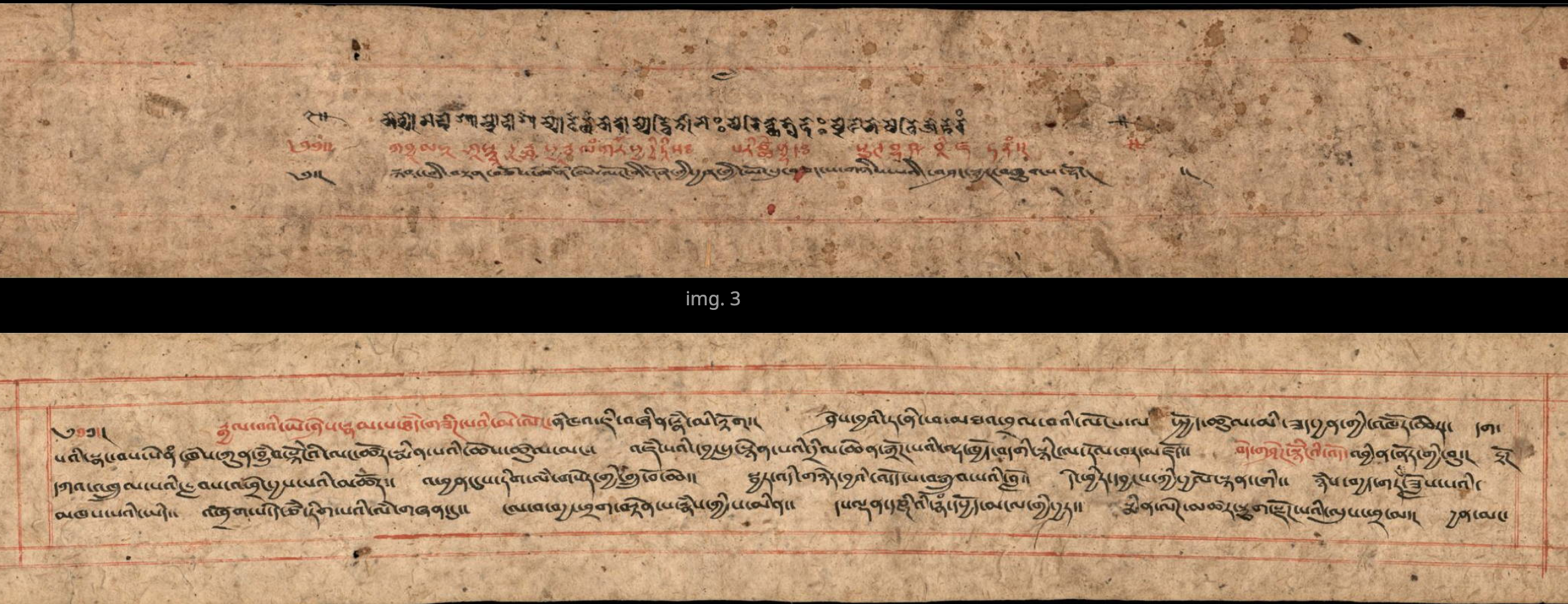
Bod Khepa wrote multiple commentaries on the Mirror of Poetry, including of course the famous Ornament of Dandin's Thought.
Select Works from the Collected Works of Bod Khepa
Bod Khepa's Collected Works is indeed a feast for scholars, and we invite all to browse through the entire collection at their leisure. We hope that readers and researchers will pay particular attention to the following texts. There is an avadana, an autobiographical narration, of his early life by Bod Khepa titled rang gi rtogs pa tshul ji lta ba bzhin brjod pa'i tshigs su bcad pa ma la ya'i rlung bzhon written in rich and complex poetry. Roughly translated as Light Breeze from Malaya: An Avadana in Verse, the 82 stanzas of this poetic narration in verse was written when Bod Khepa was only a young man of twenty four, meaning that it offers not only an early example of his poetry for interested readers, but presents a particular mode of self-representation along with information on his early spiritual development.
As one of the pre-eminent intellectuals and scholars of his time, Bod Khepa had wide-ranging correspondence with many of his contemporaries, most of whom were illustrious figures in the religious and cultural landscape of the time. Compiled here in the work chab shog phyogs bsgrigs dge legs ngag gi rol mtsho, you can see that our very helpful outline conveniently lists the name of the recipient in the title of each letter. For example, this first letter is an evocative meditation written to his root guru Sangye Dorje. The second letter is to Gampo Tulku, the reincarnation of Sepan Ralpa who was a disciple of Jetsun Milarepa. We must point out yet another letter, written to the Third Samding Dorje Phagmo, one of the very few lines of female reincarnate lamas. As you can see, his correspondents were a veritable Who's Who of the Tibetan world. The correspondence contains much work in the genres of drilen (Replies or Answers) on a range of topics reflecting Bod Khepa's varied interests and expertise, and even one Gaglen (Critique or Critical Response) as well. Perhaps close readers of these texts can even spot references to Bod Khepa's so-called rivalry with the Fifth Dalai Lama!
We are confident that these correspondences, and of course the rest of the Collected Works, will help illuminate the intellectual history of 17th century Tibet. To aid researchers, our librarians have transcribed all the colophons of the texts in the entire sungbum, so that for each text, you can see at a glance information such as who requested the text or the teaching, or where and when, or why Bod Khepa composed it. For instance, for the text below, yon bshad theg len lam gyi shing rta, we can see that it was composed by Bod Khepa for the benefit of others at Ewam Gakyil at Pal Riwoche.
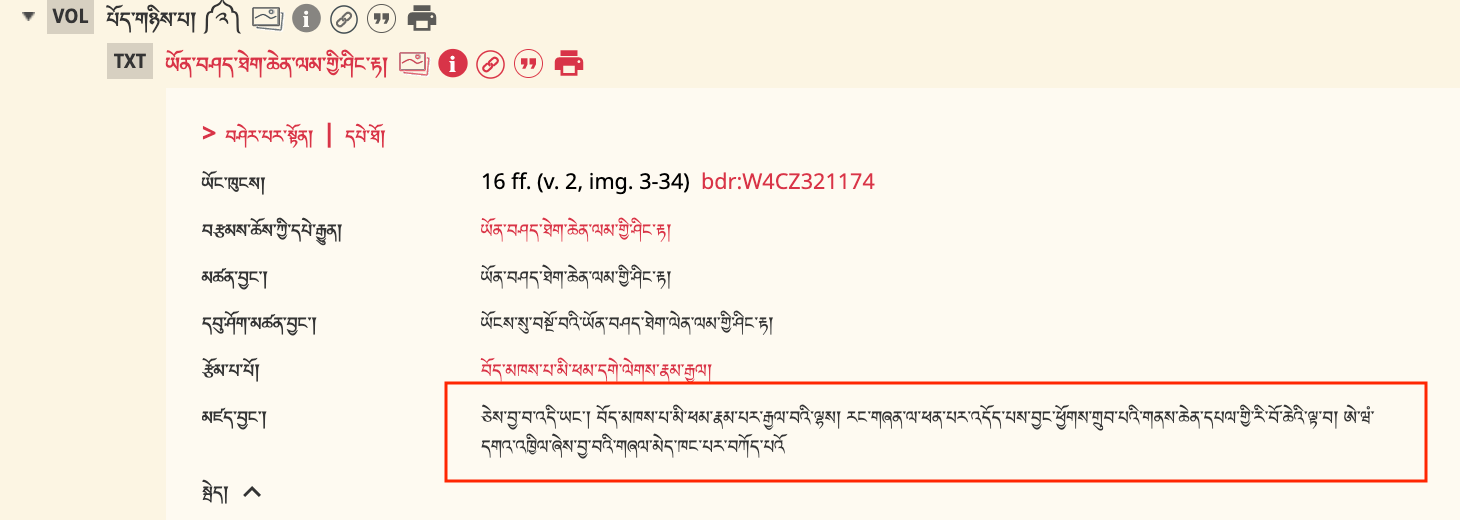
To aid researchers, our librarians have transcribed all the colophons of the texts in the entire sungbum.
To point out just a couple more works: dam pa'i chos kyi glegs bam ji ltar sgrub tshul rnam par bshad pa tshogs gnyis rin po che'i 'byung gnas is about the craft of making manuscripts, and 'jig rten khams kyi rnam gzhag gsal bar byed pa zhing khams rgya mtsho'i sprin rnam par bkod pa'i dbyangs is about cosmology.
In conclusion, the Collected Works of Bod Khepa is an indispensable source not just for Bod Khepa's life and legacy, but for the history of Tibetan poetry and the intellectual history of Tibet. We hope that Bod Khepa's wondrous Sungbum—with its scholarship and its poetry—will inspire many poems and multiple dissertations.
Happy reading!





Sorry, the comment form is closed at this time.